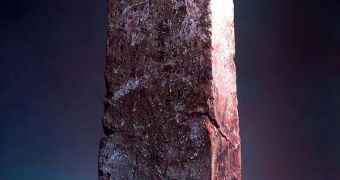A collaboration of physicists in the United States announce the development of a diamond aerogel, a new material that could have a wide array of applications. Possible uses range from improving electronics to making space exploration easier than ever before.
Also known as frozen smoke, aerogels are materials that contain up to 99.8 percent air. They are transparent, hence the name frozen smoke, but surprisingly strong, extremely efficient insulators, and capable of supporting up to several thousand times their own weight.
The image attached to this article, for example, shows a 2-gram aerogel block supporting a 2.5-kilogram brick. In the new study, experts created an even more advanced aerogel, that is based on diamonds, and is the lightest form of the carbon compound ever produced.
The way aerogels are produced is fairly simple, experts say. All you need is a gel to use as a starter material. Once you remove the liquid component in the gel, and replace it with a gas, you get a solid material that is made up of a lot of air.
The solid component is made up of resistant tangles of microscopic bead necklaces, LiveScience reports. These materials are near-perfect electric, thermal and acoustic isolators, and this further increases the array of applications they can be used for.
In the new research, experts began with a standard, carbon-based aerogel, which had its porous segments infused with neon. This prevented the entire aerogel from collapsing in on itself.
Shortly afterwards, the team subjected the aerosol sample to tremendous pressures and temperatures, forcing the carbon atoms within to shift their arrangement and create crystalline diamonds.
This study was conducted by experts at the US Department of Energy's (DOE) Lawrence Livermore National Laboratory (LANL) and the Lawrence Berkeley National Laboratory (Berkeley Lab).
“We have made, to the best of our knowledge, the lowest density form of diamond, [which can easily] be molded in a way very similar to plastic parts,” explains study researcher Peter Pauzauskie.
He holds an appointment as a materials scientist at the University of Washington. The expert adds that the new form of diamond has a density of around 40 milligrams per cubic centimeter, which is only 40 times denser than air.
Details of the new material and the team's work appear in the May 9 online issue of the esteemed journal Proceedings of the National Academy of Sciences (PNAS).

 14 DAY TRIAL //
14 DAY TRIAL //